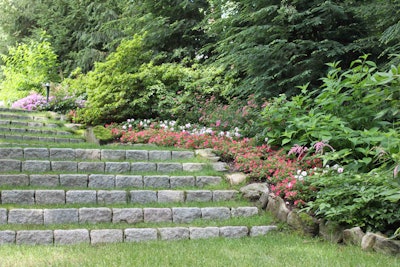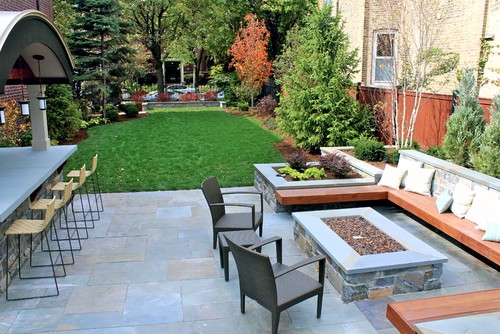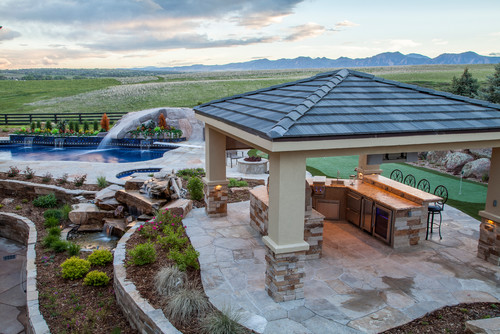 Making steps the correct height is just one of the many common mistakes, according to Jan Johnsen, author of The Spirit of Stone: 101 Practical & Creative Stonescaping Ideas for Your Garden.
Making steps the correct height is just one of the many common mistakes, according to Jan Johnsen, author of The Spirit of Stone: 101 Practical & Creative Stonescaping Ideas for Your Garden.Photo: Jan Johnsen
No one likes to make mistakes, but the lessons you learn from them gives you the experience and knowledge you need to avoid repeating the same behavior.
If you’d like to steer clear of costly errors in your landscaping business, check out the advice offered by these experienced landscapers who learned their lessons the hard way.
There’s no guarantee you’ll do every job perfectly, but being aware of some of the most common design mistakes can help you dodge certain oversights.
Look at the big picture
The majority of the time your client is working with a strict budget and this can get you caught up on focusing on just one part of the project that is going to cost the most.
If you are installing a landscape in phases, this can result in some of the new features not matching up with the rest of the design because of the heavy attention on the patio or the fire pit at one time.
“I encourage designers to always look at the entire site, even if their budget is limited to one area, draw up the whole design and then color in the one part that the customers are interested in right now,” said Cheri Stringer, landscape designer and owner of TLC Gardens based in Longmont, Colorado.

Even in small spaces like this one, larger plants can be used to make the most of the area.
Photo: Kemora Landscapes
For Stringer, by creating a design for the whole site initially, she can be sure to incorporate infrastructure for later phases.
“It’s a great way for customers to come back to you, and it helps you not undo your own work,” she said.
It is also important to think about how materials will meet in the real world. A design may seem great on paper, but when it comes to the actual construction, things don’t always play out as you thought.
According to Marisa Gora, landscape designer and owner of Kemora Landscapes based in Chicago, Illinois, sometimes when landscapers are working in small spaces they fail to think about the overall structure as a whole, instead planting insignificant material for a little bit of color.
“You need large things and things that will carry you through the seasons,” Gora said. “Start building an evenly dispersed structure of plants and then add perennials.”
Take advantage of resources
The type of mistakes you run into is directly relatable to your level of experience, and years alone will not necessarily make you wiser.
“The most common mistake that I see budding landscape designers make is not paring up with a highly seasoned and skilled landscape contractor who they can learn from,” said Michelle Derviss, landscape designer and owner of Michelle Derviss Landscape Design based in Novato, California. “This prolongs their freshman status.”
 Michelle Derviss makes sure to partner with experienced landscape contractors to bring her designs to life.
Michelle Derviss makes sure to partner with experienced landscape contractors to bring her designs to life.Photo: Michelle Derviss Landscape Design
For those who are still reluctant to reach out to those they consider their competitors, there are plenty of other resources available to expand your knowledge.
Reading articles from trade magazines like TLC is one method, and staying abreast of changes in city, county and state codes will keep you from running into any serious trouble. Joining landscape associations provides networking opportunities and can help encourage you improve your professionalism.
Gora mainly learned on her own by trying new things and branching out, but she also discovered that suppliers and installers are an untapped resource.
“There are people trying to sell you that material, so ask them questions about it,” she said. “Sometimes if it’s your first time using that material they will come out and help you install it.”
Communicate with customers
There is a difference between hearing and listening and those who listen to their customers are going to bypass a lot of design problems by making sure that they are on the same page with their clients.
The design process with customers can be tricky at times because occasionally they want something that is not feasible either because of the site or their budget. It’s your job to educate them and let them know what their options are.
“I say to them, we can plan for everything you want, but we might have to install it in phases, because you can’t do it all,” said Jan Johnsen, co-principal and owner of Johnsen Landscapes & Pools. “You just reduce the scope. You cannot sacrifice quality. That’s when it comes to consumer education.”

For expansive projects, sometimes it is best to work in phases if the customer is on a budget.
Photo: TLC Gardens
When it comes to the site being incompatible with what the client has in mind, you need to let them know early on what the constraints are so they’re aware of what they cannot have.
“Explain why you made the design choices you did and that gets away from a lot of the miscommunication at the end,” Stringer said.
Sometimes you can assume the customer understands what you have in mind, but then they are unhappy with how it turns out. It’s important to always check what their expectations are.
“I personally take responsibility if there is a misunderstanding,” Gora said. “Maybe I didn’t show them pictures, or maybe I was rushing too much. Your job is to make sure they know what they’re getting.”
Think of the future
Sometimes when designing it can be easy to only think about what the landscape will look like immediately after you’ve finished, but there are many considerations to keep in mind when choosing plant materials.
One common mistake is planting trees too close to buildings or walkways, while not considering their full height. It may look a little out of place for a while, but the final size of the plant will need that space.
“Another thing is not considering the hardiness of the plants,” Johnsen said. “Nurseries will sell beautiful plants that everybody loves, but they may be only marginally hardy for that area. After the winter, they are dead. You have to check the hardiness before you plant.”
 Choose a plant palette that will provide variety and interest throughout all the seasons.
Choose a plant palette that will provide variety and interest throughout all the seasons.Photo: Michelle Derviss Landscape Design
Speaking of the winter, if you are working in areas that receive considerable snow, be sure to choose plants that can endure being exposed to salt and beaten down by snow piles. For those dealing with drought conditions, choose plants that aren’t as needy in the water department.
It makes sense to think of what the view of the landscape will look like from the street, but you also want to be sure to design the space so it can be enjoyed from inside the house as well. Don’t plant large bushes that are going to block a beautiful view.
“Always think of the ‘what ifs’,” Johnsen said. “I always have a hypothetical drunk lady following me around: When I design something, I think, ‘what would the drunk lady do?’ This helps me prevent making mistakes. It’s a good way to design with safety and security in your head all the time.”
Derviss notes for more complicated structural work it’s important to make sure that permitting is pulled when needed because your client is adding value to the house. When they go to sell their house, they will not run into complications for having unpermitted construction on their property.
Remember the technical features
Of the four landscape designers interviewed, three of them made a point to mention grading as one of the most common landscaping design mistakes.
“Missing grade changes is common,” Stringer said. “They’re really deceiving, a lot of professionals will miss a slope change. It may seem fairly flat, but on those finished areas if it’s more than a three percent grade it’s going to be uncomfortable.”
Other technical features than can be overlooked is making walkways too narrow or outdoor steps too high. When outdoors it’s a little harder to gauge steps and there usually aren’t handrails, so a good rule of thumb is to go no higher than seven inches and to stick with six and a half inches.

Don’t forget to take a step inside to see how the space looks from the indoors.
Photo: Kemora Landscapes
Stringer advises keeping flow patterns in mind so that there is a minimum of four to six feet for walking between key areas. She also suggests making sure designs don’t result in grass areas, planting beds and hardscaping meeting at awkward shapes as this makes irrigation layouts far more difficult.
When working with hardscape material that you plan to curve, always order extra to have enough room for cuts.
One way to avoid missing certain technical details is to create a complete design and follow a checklist to make sure your rough draft contains all the necessary details.
“It’s easy to forget when you’re rushing through your deadline world,” Stringer said. “There’s an innate pressure to get it done faster, do it quick, or we’ll lose the sale. Have the checklist to know you have the space, scale, slope and drainage all included in your holistic design.”
Own up to your mistakes
What any landscaper can tell you is that you will make mistakes for one reason or the other, but there is only one good way how to handle them.
“The best thing is always just to fix it and acknowledge the responsibility of it,” Gora said. “The reputation you have with the client is more important than the money you make or lose. You can’t put the responsibility of learning on your clients. You can’t charge them for that. Eat it as part of the cost of learning.”










